Zhejiang second ophthalmology Center
Recently, Professor Yao Ke's team from the ophthalmology center of the Second Affiliated Hospital of Medical College of Zhejiang University and the ophthalmology hospital of Zhejiang University published an original research paper entitled "anti oxidative and anti inflammatory Miracles: break the dry eye vital cycle" in advanced science (zone 1 of Chinese Academy of Sciences, if: 16.806), an international famous journal in the field of biomaterials issued by Wiley.
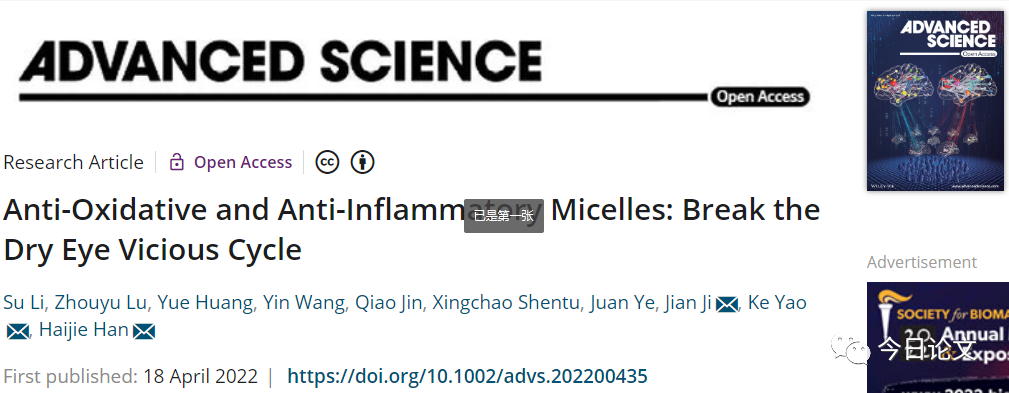
Professor Yao Ke of the eye center of the second hospital of Zhejiang University, Professor Ji Jian of the Department of polymer of Zhejiang University, and Han Haijie, a distinguished researcher of the eye center of the second hospital of Zhejiang University, are the co corresponding authors of this article, and Professor Yao Ke's graduate student Li Su is the first author of this article.
In this study, a dual antioxidant and anti-inflammatory strategy was developed. A micellar eye drops (cationic polypeptide micelles loaded with losmapimod (Los, p38 mitogen activated protein kinase (MAPK) inhibitor) and coupled with ROS scavenger tempo (TEM) (MTEM / Los) were prepared. Through antioxidant / anti-inflammatory in corneal epithelial cells and resident immune cells, it was proved to have an effective effect on the treatment of dry eye (DED) in vivo and in vitro, At the same time, it has excellent biocompatibility. This research result provides an idea for designing efficient and safe therapeutic agents for ocular surface inflammatory diseases and other oxidative stress and inflammation related diseases.
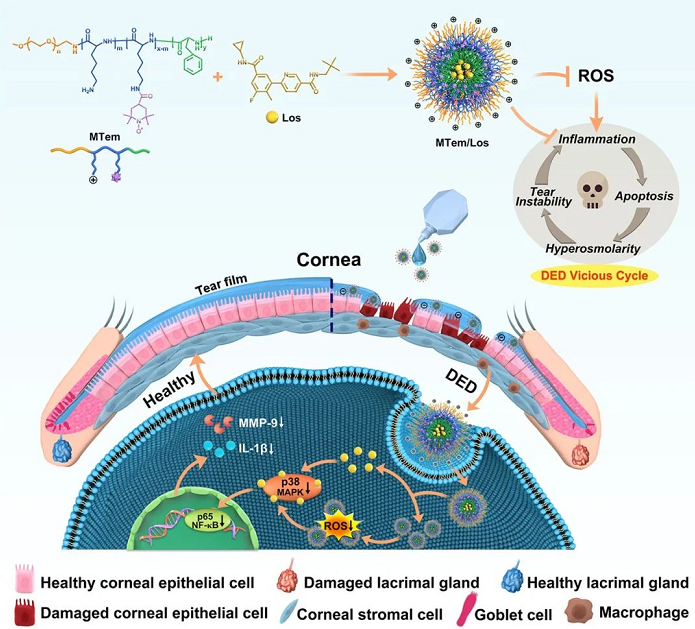
Synthesis and treatment of double effect antioxidant and anti-inflammatory polypeptide nano micelles MTEM / Los
01
Part 1 highlights of this article
1. Micellar eye drops MTEM / Los with antioxidant, anti-inflammatory and corneal targeting functions were successfully prepared. The preparation is simple and the administration is convenient.
2. According to the etiology of dry eye disease, the upstream ROS activator and p38 inhibitor in MAPK pathway were designed, and the downstream inflammatory level was successfully and efficiently inhibited, which provided ideas and strategies for the treatment of dry eye disease.
3. MTEM / Los showed excellent therapeutic effect for dry eye, and compared with commercial restasis ® With faster and more effective effect and good biocompatibility, it may become a new weapon for the treatment of and other oxidative stress and inflammation related diseases.
02
Part 2 research background
Dry eye disease (DED) is a kind of ocular surface disease caused by many factors, which has a high incidence rate and is difficult to cure. This multifactorial disease worsens the pathological process, that is, the vicious circle of DED makes the therapeutic effect of monotherapy poor. Inflammation is the core of ded and plays a key role in the vicious circle. Reactive oxygen species (ROS) can act extensively upstream on multiple nodes in the vicious cycle, including inflammation. P38 MAPK, as an important target in anti-inflammatory therapy, can effectively inhibit the expression of inflammatory cytokines and eliminate apoptotic cells.
Losmapimod (LOS) is a safe and well tolerated p38 MAPK inhibitor. It has been reported to have significant therapeutic effects in the clinical application of a variety of systemic diseases. Superoxide dismutase mimetic compound tempo (TEM) is a cheap and stable nitrogen oxide free radical with strong antioxidant activity. Its derivatives, nano drugs and gel have been widely used in various diseases. In view of this, the authors developed a new, safe and efficient micellar eye drops, which is mainly composed of amphiphilic cationic polypeptide micelles loaded with LOS and equipped with TEM - MTEM / Los for the collaborative treatment of DED.
03
Part 3 material characterization
Yaoke team first characterized the prepared double effect antioxidant / anti-inflammatory nano micelles MTEM / Los. EPR, DLS, TEM and other experimental results suggest that MTEM / Los has been successfully prepared, has a good scavenging function for ROS, and shows stable properties in lysosomes.
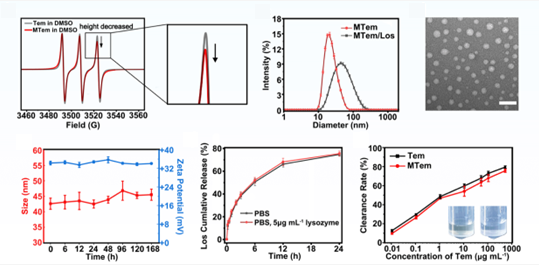
The results of material characterization suggest the successful preparation of MTEM / Los
04
Experimental study on Part 4 cells
In order to explore the therapeutic mechanism of MTEM / Los on ded, Professor Yaoke's team decided to use two cell models of corneal epithelial cells (HCE) and macrophages (raw 264.7) in vitro to verify the mechanism and evaluate its effect. The research team found that MTEM / Los can double effectively inhibit the production of ROS and p38 MAPK site in HCE and raw 264.7 cell lines, so as to reduce the expression of downstream inflammation related and chemotaxis related genes, and inhibit HCE cell apoptosis and pro-inflammatory phenotype conversion.
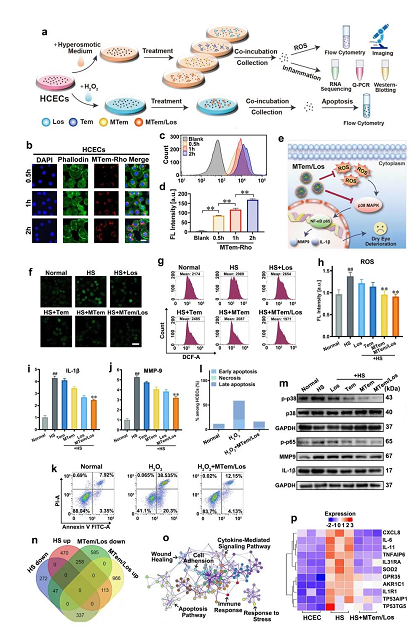
The study revealed that MTEM / Los could be efficiently absorbed by HCE cells and raw 264.7 cells, and showed excellent effects of anti ROS, anti inflammation, anti apoptosis and inhibiting inflammatory polarization
05
Part 5 new treatment strategy
In order to further explore the application effect of MTEM / Los in animals, Yaoke team chose to construct a ded experimental mouse model for treatment. The treatment effect of MTEM / Los in DED was evaluated and analyzed by various methods such as evaluation of clinical indicators related to ded, evaluation of ocular surface retention ability, histological morphology and immunofluorescence images. The team found that MTEM / Los treatment effectively restored the ocular surface structure morphologically by inhibiting ROS overexpression, inflammatory response, apoptosis and squamous metaplasia, thus realizing the efficient treatment of DED.
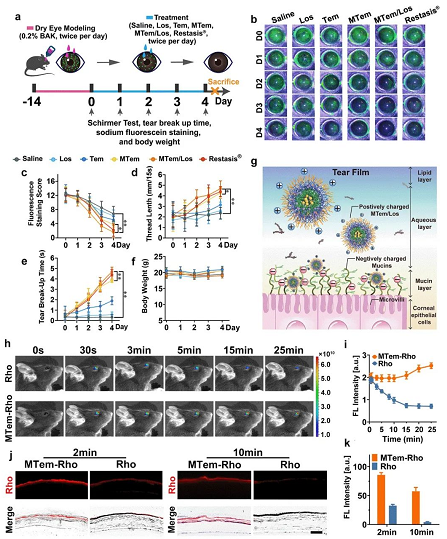
Studies have shown that MTEM / Los can improve the clinical therapeutic effect in DED mice, and MTEM has excellent ocular surface retention ability

The study further revealed that MTEM / Los has a good ability to restore the ocular structure and explore the related immunological mechanism in DED mice
06
Part 6 summary and Prospect
In this work, a cationic polypeptide micellar eye drops MTEM / Los loaded with p38 MAPK inhibitor LOS and coupled antioxidant TEM was designed and prepared. It can effectively inhibit the formation of DES / ROS and the deterioration of bad circulation through the pathways of apoptosis and Los; MTEM / Los itself has good biosafety and eye tolerance, and is expected to be used in more clinical applications of oxidative stress and inflammatory related diseases in the future.
Original link: https://onlinelibrary.wiley.com/doi/10.1002/advs.202200435